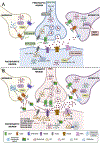Mini-review: The therapeutic role of cannabinoids in neuroHIV
- PMID: 33587986
- PMCID: PMC7994193
- DOI: 10.1016/j.neulet.2021.135717
Mini-review: The therapeutic role of cannabinoids in neuroHIV
Abstract
In the era of combined antiretroviral therapy (cART), human immunodeficiency virus type 1 (HIV-1) is considered a chronic disease with an inflammatory component that specifically targets the brain and causes a high prevalence of HIV-1-associated neurocognitive disorders (HAND). The endocannabinoid (eCB) system has attracted interest as a target for treatment of neurodegenerative disorders, due to the potential anti-inflammatory and neuroprotective properties of cannabinoids, including its potential therapeutic use in HIV-1 neuropathogenesis. In this review, we summarize what is currently known about the structural and functional changes of the eCB system under conditions of HAND. This will be followed by summarizing the current clinical and preclinical findings on the effects of cannabis use and cannabinoids in the context of HIV-1 infection, with specifically focusing on viral load, cognition, inflammation, and neuroprotection. Lastly, we present some potential future directions to better understand the involvement of the eCB system and the role that cannabis use and cannabinoids play in neuroHIV.
Keywords: Antiretroviral therapy; C-C motif chemokine receptor 5 (CCR5); C-X-C motif chemokine receptor 4 (CXCR4); Cannabinoid type 1 receptor; Cannabinoid type 2 receptor; Cannabis; Endogenous cannabinoid system; Fatty acid amide hydrolase; G-protein coupled receptor (GPCR) GPR18; HIV-associated neurocognitive disorders; Inflammation; MJN110; Microglia; Monoacylglycerol lipase; Neurodegeneration; PF3845; Synaptodendritic degeneration; neuroHIV; Δ(9)-tetrahydrocannabinol.
Copyright © 2021 The Author(s). Published by Elsevier B.V. All rights reserved.
Conflict of interest statement
Declaration of interest
The authors declare that they have no competing interests.
Figures

Similar articles
-
Targeting Cannabinoid Receptor 2 on Peripheral Leukocytes to Attenuate Inflammatory Mechanisms Implicated in HIV-Associated Neurocognitive Disorder.J Neuroimmune Pharmacol. 2020 Dec;15(4):780-793. doi: 10.1007/s11481-020-09918-7. Epub 2020 May 14. J Neuroimmune Pharmacol. 2020. PMID: 32409991 Free PMC article. Review.
-
A helping HAND: therapeutic potential of MAGL inhibition against HIV-1-associated neuroinflammation.Front Immunol. 2024 May 21;15:1374301. doi: 10.3389/fimmu.2024.1374301. eCollection 2024. Front Immunol. 2024. PMID: 38835765 Free PMC article.
-
Druggable targets of the endocannabinoid system: Implications for the treatment of HIV-associated neurocognitive disorder.Brain Res. 2019 Dec 1;1724:146467. doi: 10.1016/j.brainres.2019.146467. Epub 2019 Sep 17. Brain Res. 2019. PMID: 31539547 Free PMC article. Review.
-
Inhibitory Neurotransmission Is Sex-Dependently Affected by Tat Expression in Transgenic Mice and Suppressed by the Fatty Acid Amide Hydrolase Enzyme Inhibitor PF3845 via Cannabinoid Type-1 Receptor Mechanisms.Cells. 2022 Mar 2;11(5):857. doi: 10.3390/cells11050857. Cells. 2022. PMID: 35269478 Free PMC article.
-
GPR18 drives FAAH inhibition-induced neuroprotection against HIV-1 Tat-induced neurodegeneration.Exp Neurol. 2021 Jul;341:113699. doi: 10.1016/j.expneurol.2021.113699. Epub 2021 Mar 15. Exp Neurol. 2021. PMID: 33736974 Free PMC article.
Cited by
-
Twelve-year neurocognitive decline in HIV is associated with comorbidities, not age: a CHARTER study.Brain. 2023 Mar 1;146(3):1121-1131. doi: 10.1093/brain/awac465. Brain. 2023. PMID: 36477867 Free PMC article.
-
Acute Effects of Monoacylglycerol Lipase Inhibitor ABX1431 on Neuronal Hyperexcitability, Nociception, Locomotion, and the Endocannabinoid System in HIV-1 Tat Male Mice.Cannabis Cannabinoid Res. 2024 Dec;9(6):1500-1513. doi: 10.1089/can.2023.0247. Epub 2024 Feb 23. Cannabis Cannabinoid Res. 2024. PMID: 38394322 Free PMC article.
-
Monoacylglycerol Lipase Inhibitor MJN110 Reduces Neuronal Hyperexcitability, Restores Dendritic Arborization Complexity, and Regulates Reward-Related Behavior in Presence of HIV-1 Tat.Front Neurol. 2021 Aug 16;12:651272. doi: 10.3389/fneur.2021.651272. eCollection 2021. Front Neurol. 2021. PMID: 34484091 Free PMC article.
-
Cannabis and Inflammation in HIV: A Review of Human and Animal Studies.Viruses. 2021 Aug 2;13(8):1521. doi: 10.3390/v13081521. Viruses. 2021. PMID: 34452386 Free PMC article. Review.
-
Central Nervous System Impact of Perinatally Acquired HIV in Adolescents and Adults: an Update.Curr HIV/AIDS Rep. 2022 Feb;19(1):121-132. doi: 10.1007/s11904-021-00598-3. Epub 2022 Feb 2. Curr HIV/AIDS Rep. 2022. PMID: 35107809 Free PMC article. Review.
References
-
- Abrams DI, Hilton JF, Leiser RJ, Shade SB, Elbeik TA, Aweeka FT, Benowitz NL, Bredt BM, Kosel B, Aberg JA, Deeks SG, Mitchell TF, Mulligan K, Bacchetti P, McCune JM, Schambelan M, Short-term effects of cannabinoids in patients with HIV-1 infection: a randomized, placebo-controlled clinical trial, Ann Intern Med 139 (2003) 258–266. - PubMed
-
- Abrams DI, Jay CA, Shade SB, Vizoso H, Reda H, Press S, Kelly ME, Rowbotham MC, Petersen KL, Cannabis in painful HIV-associated sensory neuropathy: a randomized placebo-controlled trial, Neurology 68 (2007) 515–521. - PubMed
-
- Adle-Biassette H, Levy Y, Colombel M, Poron F, Natchev S, Keohane C, Gray F, Neuronal apoptosis in HIV infection in adults, Neuropathol Appl Neurobiol 21 (1995) 218–227. - PubMed
-
- Aghazadeh Tabrizi M, Baraldi PG, Borea PA, Varani K, Medicinal Chemistry, Pharmacology, and Potential Therapeutic Benefits of Cannabinoid CB2 Receptor Agonists, Chem Rev 116 (2016) 519–560. - PubMed
-
- Ahn K, Johnson DS, Mileni M, Beidler D, Long JZ, McKinney MK, Weerapana E, Sadagopan N, Liimatta M, Smith SE, Lazerwith S, Stiff C, Kamtekar S, Bhattacharya K, Zhang Y, Swaney S, Van Becelaere K, Stevens RC, Cravatt BF, Discovery and characterization of a highly selective FAAH inhibitor that reduces inflammatory pain, Chem Biol 16 (2009) 411–420. - PMC - PubMed
Publication types
MeSH terms
Substances
Grants and funding
LinkOut - more resources
Full Text Sources
Other Literature Sources

